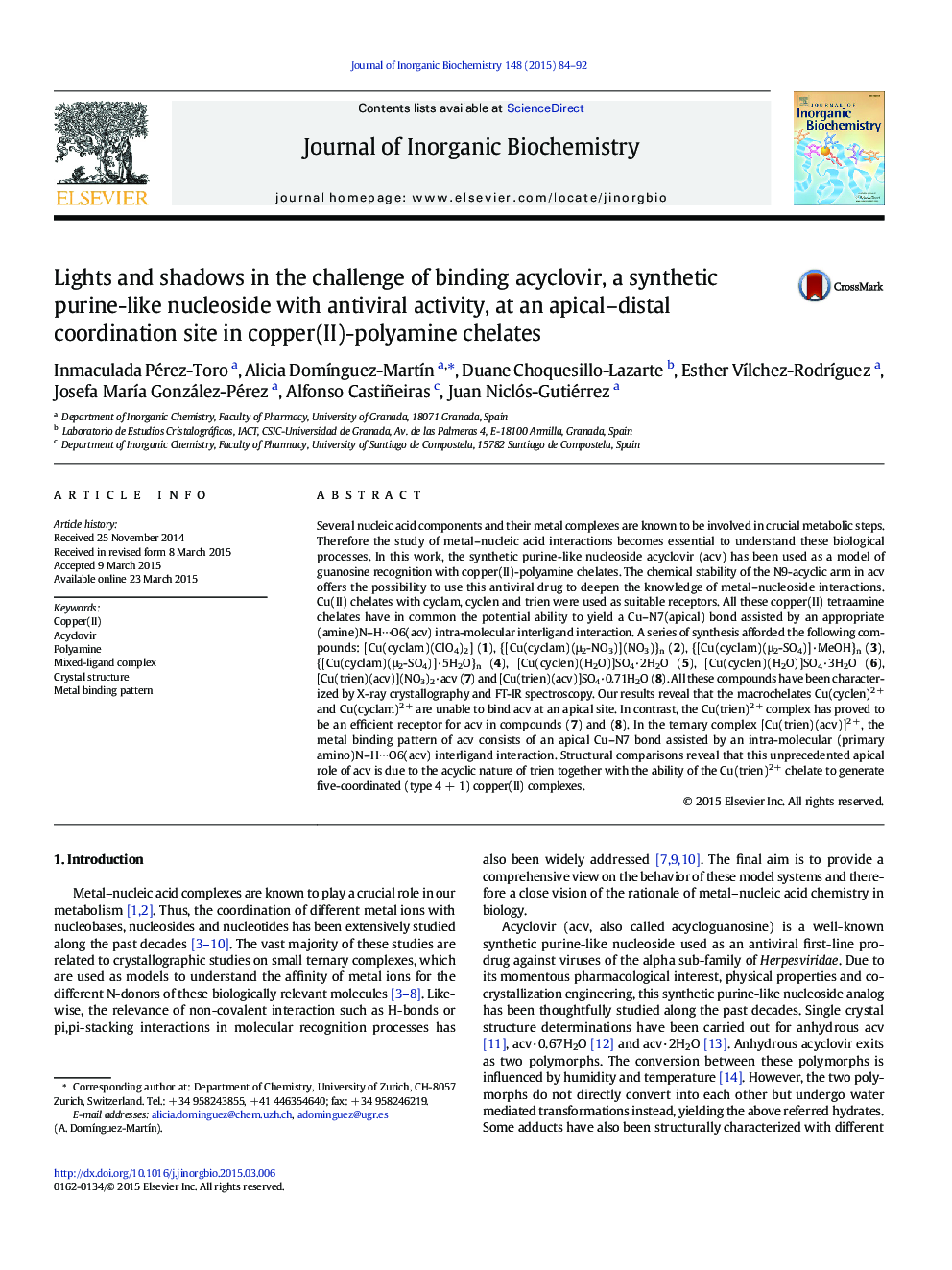| کد مقاله | کد نشریه | سال انتشار | مقاله انگلیسی | نسخه تمام متن |
|---|---|---|---|---|
| 1316073 | 1499439 | 2015 | 9 صفحه PDF | دانلود رایگان |

• The synthetic purine-like nucleoside acyclovir is used for metal recognition studies.
• Cu(II) chelates of cyclam, cyclen or trien were used as potential acyclovir receptors.
• Only Cu(trien)2 + yielded the ternary complex [Cu(trien)(acv)]2 +(sulfate or nitrate).
• Unprecedented apical coordination of the N7–acv donor in the 4 + 1 Cu(II) coordination
• The Cu–N7(acv) bond is assisted by a (trien)N–H⋯O6(acv) interaction.
Several nucleic acid components and their metal complexes are known to be involved in crucial metabolic steps. Therefore the study of metal–nucleic acid interactions becomes essential to understand these biological processes. In this work, the synthetic purine-like nucleoside acyclovir (acv) has been used as a model of guanosine recognition with copper(II)-polyamine chelates. The chemical stability of the N9-acyclic arm in acv offers the possibility to use this antiviral drug to deepen the knowledge of metal–nucleoside interactions. Cu(II) chelates with cyclam, cyclen and trien were used as suitable receptors. All these copper(II) tetraamine chelates have in common the potential ability to yield a Cu–N7(apical) bond assisted by an appropriate (amine)N–H⋯O6(acv) intra-molecular interligand interaction. A series of synthesis afforded the following compounds: [Cu(cyclam)(ClO4)2] (1), {[Cu(cyclam)(μ2-NO3)](NO3)}n (2), {[Cu(cyclam)(μ2-SO4)]·MeOH}n (3), {[Cu(cyclam)(μ2-SO4)]·5H2O}n (4), [Cu(cyclen)(H2O)]SO4·2H2O (5), [Cu(cyclen)(H2O)]SO4·3H2O (6), [Cu(trien)(acv)](NO3)2·acv (7) and [Cu(trien)(acv)]SO4·0.71H2O (8). All these compounds have been characterized by X-ray crystallography and FT-IR spectroscopy. Our results reveal that the macrochelates Cu(cyclen)2 + and Cu(cyclam)2 + are unable to bind acv at an apical site. In contrast, the Cu(trien)2 + complex has proved to be an efficient receptor for acv in compounds (7) and (8). In the ternary complex [Cu(trien)(acv)]2 +, the metal binding pattern of acv consists of an apical Cu–N7 bond assisted by an intra-molecular (primary amino)N–H⋯O6(acv) interligand interaction. Structural comparisons reveal that this unprecedented apical role of acv is due to the acyclic nature of trien together with the ability of the Cu(trien)2 + chelate to generate five-coordinated (type 4 + 1) copper(II) complexes.
To address the challenge of binding the synthetic purine-like nucleoside acyclovir at an apical Cu(II) coordination site, cyclen, cyclam and trien tetraamine chelators were used as suitable receptors. Only the Cu(trien)2 + chelate was able to bind acyclovir as expected. The N7–acv bond cooperates with an intra-molecular N–H⋯O6(acv) interaction.Figure optionsDownload as PowerPoint slide
Journal: Journal of Inorganic Biochemistry - Volume 148, July 2015, Pages 84–92